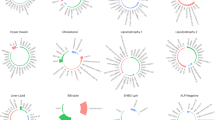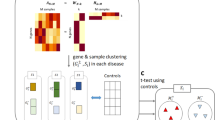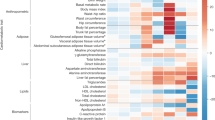Abstract
We previously localized type 2 diabetes (T2D)-susceptibility genes to five chromosomal regions through a genome-wide linkage scan of T2D and age of diagnosis (AOD) in the African American subset of the GENNID sample. To follow up these findings, we repeated the linkage and association analysis using genotypes on an additional 9203 fine-mapping single nucleotide polymorphisms (SNPs) selected to tag genes under the linkage peaks. In each of the five regions, we confirmed linkage and inferred the presence of ⩾2 susceptibility genes. The evidence of multiple susceptibility genes consisted of: (1) multiple linkage peaks in four of the five regions; and (2) association of T2D and AOD with SNPs within ⩾2 genes in every region. The associated genes included 3 previously reported to associate with T2D or related traits (GRB10, NEDD4L, LIPG) and 24 novel candidate genes, including genes in lipid metabolism (ACOXL) and cell–cell and cell–matrix adhesion (MAGI2, CLDN4, CTNNA2).
Similar content being viewed by others
Log in or create a free account to read this content
Gain free access to this article, as well as selected content from this journal and more on nature.com
or
References
Stone, S., Abkevich, V., Hunt, S. C., Gutin, A., Russell, D. L., Neff, C. D. et al. A major predisposition locus for severe obesity, at 4p15-p14. Am. J. Hum. Genet. 70, 1459–1468 (2002).
Stone, S., Abkevich, V., Russell, D. L., Riley, R., Timms, K., Tran, T. et al. TBC1D1 is a candidate for a severe obesity gene and evidence for a gene/gene interaction in obesity predisposition. Hum. Mol. Genet. 15, 2709–2720 (2006).
Ewing, C. M., Ray, A. M., Lange, E. M., Zuhlke, K. A., Robbins, C. M., Tembe, W. D. et al. Germline mutations in HOXB13 and prostate-cancer risk. N. Engl. J. Med. 366, 141–149 (2012).
Martin, L. J., Kissebah, A. H. & Olivier, M. Accounting for a quantitative trait locus for plasma triglyceride levels: utilization of variants in multiple genes. PLoS ONE 7, e34614 (2012).
Christians, J. K. & Keightley, P. D. Fine mapping of a murine growth locus to a 1.4-cM region and resolution of linked QTL. Mamm. Genome 15, 482–491 (2004).
Christians, J. K., Hoeflich, A. & Keightley, P. D. PAPPA2, an enzyme that cleaves an insulin-like growth-factor-binding protein, is a candidate gene for a quantitative trait locus affecting body size in mice. Genetics 173, 1547–1553 (2006).
Prokopenko, I., Zeggini, E., Hanson, R. L., Mitchell, B. D., Rayner, N. W., Akan, P. et al. Linkage disequilibrium mapping of the replicated type 2 diabetes linkage signal on chromosome 1q. Diabetes 58, 1704–1709 (2009).
Das, S. K. & Elbein, S. C. The genetic basis of type 2 diabetes. Cellscience 2, 100–131 (2006).
Elbein, S. C. Evaluation of polymorphisms known to contribute to risk for diabetes in African and African-American populations. Curr. Opin. Clin. Nutr. Metab. Care 10, 415–419 (2007).
Smith, L. M., Yao-Borengasser, A., Starks, T., Tripputi, M., Kern, P. A. & Rasouli., N. Insulin resistance in African-American and Caucasian women: differences in lipotoxicity, adipokines, and gene expression in adipose tissue and muscle. J. Clin. Endocrinol. Metab. 95, 4441–4448 (2010).
Elbein, S. C., Kern, P. A., Rasouli, N., Yao-Borengasser, A., Sharma, N. K. & Das, S. K. Global gene expression profiles of subcutaneous adipose and muscle from glucose-tolerant, insulin-sensitive, and insulin-resistant individuals matched for BMI. Diabetes 60, 1019–1029 (2011).
Wheeler, E. & Barroso, I. Genome-wide association studies and type 2 diabetes. Brief Funct. Genomics 10, 52–60 (2011).
Langberg., K. A., Ma, L., Sharma, N. K., Hanis, C. L., Elbein, S. C., Hasstedt, S. J. et al. Single nucleotide polymorphisms in JAZF1 and BCL11A gene are nominally associated with type 2 diabetes in African-American families from the GENNID study. J. Hum. Genet. 57, 57–61 (2012).
Palmer, N. D., McDonough, C. W., Hicks, P. J., Roh, B. H., Wing, M. R., An, S. S. et al. A genome-wide association search for type 2 diabetes genes in African Americans. PLoS One 2, e29202 (2012).
McCarthy, M. I. & Zeggini, E. Genome-wide association studies in type 2 diabetes. Curr. Diab. Rep. 9, 164–171 (2009).
Elbein, S. C., Das, S. K., Hallman, D. M., Hanis, C. L. & Hasstedt, S. J. Genome-wide linkage and admixture mapping of type 2 diabetes in African American families from the American Diabetes Association GENNID (Genetics of NIDDM) Study Cohort. Diabetes 58, 268–274 (2009).
Hasstedt, S. J., Hanis, C. L. & Elbein, S. C. Univariate and bivariate linkage analysis identifies pleiotropic loci underlying lipid levels and type 2 diabetes risk. Ann. Hum. Genet. 74, 308–315 (2010).
Hasstedt, S. J., Hanis, C. L., Das, S. K. & Elbein, S. C. Pleiotropy of type 2 diabetes with obesity. J. Hum. Genet. 56, 491–495 (2011).
Raffel, L. J., Robbins, D. C., Norris, J. M., Boerwinkle, E., DeFronzo, R. A., Elbein, S. C. et al. The GENNID Study. A resource for mapping the genes that cause NIDDM. Diabetes Care 19, 864–872 (1996).
Edlund, C. K., Lee, W., Hl, L. D., Van Den Berg, D. J. & Conti, D. V. Snagger: A user-friendly program for incorporating additional information for tagSNP selection. BMC Bioinformatics 9, 174 (2008).
O'Connell, J. R. & Weeks, D. E. PedCheck: a program for identification of genotype incompatibilities in linkage analysis. Am. J. Hum. Genet. 63, 259–266 (1998).
Abecasis, G. R., Cherny, S. S., Cookson, W. O. & Cardon, L. R. Merlin—rapid analysis of dense genetic maps using sparse gene flow trees. Nat. Genet. 30, 97–101 (2002).
Hasstedt, P. A. P. Document-driven software for genetic analysis. Genet. Epidemiol. 29, 255 (2005).
Hasstedt, S. J. & Thomas, A. Detecting pleiotropy and epistasis using variance components linkage analysis in jPAP. Hum. Hered. 72, 258–263 (2011).
Benjamini, Y. & Hochberg, Y. Controlling the false discovery rate: a practical and powerful approach to multiple testing. J. R. Stat. Soc. B 57, 289–300 (1995).
Benjamini, Y., Heller, R. & Yekutieli, D. Selective inference in complex research. Philos. Transact. R. Soc. A Math. Phys. Eng. Sci. 367, 4255–4271 (2009).
Di Paola, R., Wojcik, J., Succurro, E., Marucci, A., Chandalia, M., Padovano, L. et al. GRB10 gene and type 2 diabetes in whites. J. Intern. Med. 267, 132–133 (2010).
McDonough, C. W., Bostrom, M. A., Lu, L., Hicks, P. J., Langefeld, C. D., Divers, J. et al. Genetic analysis of diabetic nephropathy on chromosome 18 in African Americans: linkage analysis and dense SNP mapping. Hum. Genet. 126, 805–817 (2009).
Willer, C. J., Sanna, S., Jackson, A. U., Scuteri, A., Bonnycastle, L. L., Clarke, R. et al. Newly identified loci that influence lipid concentrations and risk of coronary artery disease. Nat. Genet. 40, 161–169 (2008).
Schubert, C. The genomic basis of the Williams-Beuren syndrome. Cell Mol. Life Sci. 66, 1178–1197 (2009).
Pober, B. R., Wang, E., Caprio, S., Petersen, K. F., Brandt, C., Stanley, T. et al. High prevalence of diabetes and pre-diabetes in adults with Williams syndrome. Am. J. Med. Genet. C Simin. Med. Genet. 15, 291–298 (2010).
Torgerson, D. G., Capurso, D., Mathias, R. A., Graves, P. E., Hernandez, R. D., Beaty, T. H. et al. Resequencing candidate genes implicates rare variants in asthma susceptibility. Am. J. Hum. Genet. 90, 273–281 (2012).
Duez, H., Cariou, B. & Staels, B. DPP-4 inhibitors in the treatment of type 2 diabetes. Biochem. Pharmacol. 83, 823–832 (2012).
Qi, S. Y., Riviere, P. J., Trojnar, J., Junien, J. L. & Akinsanya, K. O. Cloning and characterization of dipeptidyl peptidase 10, a new member of an emerging subgroup of serine proteases. Biochem. J. 373 (Pt 1), 179–189 (2003).
Grundberg, E., Small, K. S., Hedman, A. K., Nica, A. C., Buil, A., Keidson, S. et al. Mapping cis- and trans-regulatory effects across multiple tissues in twins. Nat. Genet. 44, 1084–1089 (2012).
Acknowledgements
This project was funded by NIH Grant DK071100. This study was supported by the American Diabetes Association. Genotyping services were provided by the Center for Inherited Disease Research (CIDR). CIDR is fully funded through a federal contract from the National Institutes of Health to The Johns Hopkins University, contract number HHSN268200782096C.
Author information
Authors and Affiliations
Consortia
Corresponding author
Additional information
Supplementary Information accompanies the paper on Journal of Human Genetics website
Supplementary information
APPENDIX
APPENDIX
American diabetes association GENNID study group
Genetic material collected by, and families characterized by, the American Diabetes Association GENNID Study Group, which includes Eric Boerwinkle, PhD, University of Texas Health Science Center; John Buse, MD, PhD, University of North Carolina; Ralph DeFronzo, MD, University of Texas Health Science Center; David Ehrmann, MD, University of Chicago; Steven C. Elbein, MD, University of Utah/University of Arkansas; Wilfred Fujimoto, MD and Steven E. Kahn, MB, ChB, University of Washington; Craig L. Hanis, PhD, University of Texas Health Science Center; Richard A. Mulivor, PhD and Jeanne C. Beck, PhD, Coriell Cell Repositories; Jill Norris, PhD, University of Colorado School of Medicine; M. Alan Permutt, MD and Philip Behn, MD, Washington University School of Medicine; Leslie Raffel, MD, Cedars-Sinai Medical Center; and David C. Robbins, MD, Medlantic Research Institute.
Rights and permissions
About this article
Cite this article
Hasstedt, S., Highland, H., Elbein, S. et al. Five linkage regions each harbor multiple type 2 diabetes genes in the African American subset of the GENNID Study. J Hum Genet 58, 378–383 (2013). https://doi.org/10.1038/jhg.2013.21
Received:
Revised:
Accepted:
Published:
Issue date:
DOI: https://doi.org/10.1038/jhg.2013.21
Keywords
This article is cited by
-
Bayesian variable selection for high dimensional predictors and self-reported outcomes
BMC Medical Informatics and Decision Making (2020)
-
Genetics of Type 2 Diabetes in African Americans
Current Diabetes Reports (2015)



